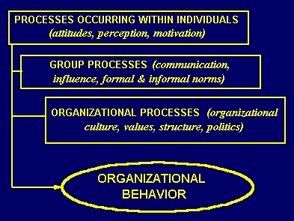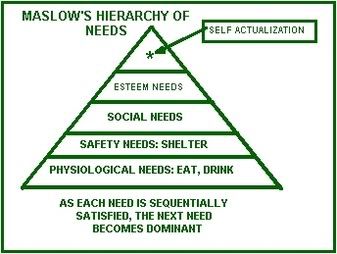Introduction to Organizational Behavior
ORGANIZATIONAL BEHAVIOR
An organization is a complex, competitive world. It reflects the image of its people. Their relationship should be built on trust and confidence. On the other hand, behavior is a manner of reaction, deportment, the expression of habits or tendencies of people.
As a concept, human behavior in organizations is not new. There is, however, a problem in understanding it. Some people put emphasis on human behavior, while others on organization.
According to Ramon J. Aldag and Arthur P. Brief, “organizational behavior is a branch of social sciences that seeks to build theories that can be applied to predicting, understanding and influencing behavior in work organization.”
Organizational behavior appears to be a simple subject. After all everyone has learned something about human behavior from his or her own unique experiences with people.
Diagram below could help us in visualizing what is organizational behavior is all about.

Organizational Behavior discusses about individuals in an organization as well as group and organizational process. Individuals are unique in terms of their attitudes, perception, personalities and motivation. These are oftentimes influenced by heredity and environment. Common goals and interests bind individual to form a group. Group may be formal or informal in form. Formal group includes task and command group which performs specific task and functional reporting relationships. Informal group includes friendship and interest group. Organizational processes include organizational culture, values, structure and politics. Organizational culture is a pattern of basic assumptions that are considered valid and are taught to new members as the way to perceive, think and feel in the organization.
Elements of Organizational Behavior
The organization's base rests on management's philosophy, values, vision and goals. This in turn drives the organizational culture which is composed of the formal organization, informal organization, and the social environment. The culture determines the type of leadership, communication, and group dynamics within the organization. The workers perceive this as the quality of work life which directs their degree of motivation. The final outcome are performance, individual satisfaction, and personal growth and development. All these elements combine to build the model or framework that the organization operates from.
Models of Organizational Behavior
There are four major models or frameworks that organizations operate out of:
Autocratic - The basis of this model is power with a managerial orientation of authority. The employees in turn are oriented towards obedience and dependence on the boss. The employee need that is met is subsistence. The performance result is minimal.
Custodial - The basis of this model is economic resources with a managerial orientation of money. The employees in turn are oriented towards security and benefits and dependence on the organization. The employee need that is met is security. The performance result is passive cooperation.
Supportive - The basis of this model is leadership with a managerial orientation of support. The employees in turn are oriented towards job performance and participation. The employee need that is met is status and recognition. The performance result is awakened drives.
Collegial - The basis of this model is partnership with a managerial orientation of teamwork. The employees in turn are oriented towards responsible behavior and self-discipline. The employee need that is met is self-actualization. The performance result is moderate enthusiasm.
Although there are four separate models, almost no organization operates exclusively in one. There will usually be a predominate one, with one or more areas over-lapping in the other models.
The first model, autocratic, had its roots in the industrial revolution. The managers of this type of organization operate out of McGregor's Theory X. The next three models begin to build on McGregor's Theory Y. They have each evolved over a period of time and there is no one "best" model. The collegial model should not be thought as the last or best model, but the beginning of a new model or paradigm.
WHY INDIVIDUAL DIFFERENCES ARE IMPORTANT
Individual differences are important in studying organizational behavior and management for a very important reason: Individual differences have a direct effect on behavior. Every person is unique because of their background, individual characteristics, needs, and how they perceive the world and other individuals.
HUMAN MOTIVATION
Human behavior in organizations may be affected by the individual’s motivation. There are five motives for working as identified by James W. Kalat. They are as follows:
People work for a variety of motives one is money. A second is status. Many jobs provide prestige and even the lowliest job is more prestigious than no job at all. A third motive is social interaction. Most workers enjoy their dealings with co-workers, clients and supervisors. A fourth motive is pride of accomplishment. Most people believe their work contributes in some way to the betterment of society. A fifth motive is physical activity. Although people dislike jobs that drain their energies, many workers welcome a moderate amount of physical exertion on the job.
Motivation has been defined in many ways. It is defined as drives, urges, wishes or desires that initiate the sequence of events known as behavior. It is also the force which leads a person to act in a particular way in response to a need. Need is a deprivation felt when physical or emotional balance is disturbed. Needs are either primary or secondary. Primary needs are the inborn or physiological needs for food, water, rest, sleep, air to breath and sex. Secondary needs arise from individual’s interaction with the environment, and are not inborn but develop with maturity. Secondary needs include those for safety and security, belongingness and social relations and self-esteem and self respect.
In the theory of human needs, Abraham H. Maslow, psychologist, presented three specific assumptions:
1. Human beings are never satisfied. Their wants are determined by what they have.
2. A satisfied need does not cause behavior. Once people satisfy their need for safety, they are motivated by as yet unsatisfied needs, not ones that are satisfied.
3. Human needs are arranged in hierarchy of importance.
HUMAN NEEDS
Abraham Maslow is known for establishing the theory of a hierarchy of needs, writing that human beings are motivated by unsatisfied needs, and that certain lower needs need to be satisfied before higher needs can be satisfied.

According to Maslow, there are general types of needs (physiological, safety, love, and esteem) that must be satisfied before a person can act unselfishly. He called these needs "deficiency needs." As long as we are motivated to satisfy these cravings, we are moving towards growth, toward self-actualization. Satisfying needs is healthy; blocking gratification makes us sick or evil. In other words, we are all "needs junkies" with cravings that must be satisfied and should be satisfied. Else, we become sick.
At once other (and higher) needs emerge, and these, rather than physiological hungers, dominate the organism. And when these in turn are satisfied, again new (and still higher) needs emerge, and so on. As one desire is satisfied, another pops up to take its place.
Physiological Needs are the very basic needs such as air, water, food, sleep, sex, etc. When these are not satisfied we may feel sickness, irritation, pain, discomfort, etc. These feelings motivate us to alleviate them as soon as possible to establish homeostasis. Once they are alleviated, we may think about other things.
Safety Needs
If the physiological needs are relatively well gratified, there then emerges a new set of needs, which we may categorize roughly as the safety needs.
Safety needs have to do with establishing stability and consistency in a chaotic world. These needs are mostly psychological in nature. We need the security of a home and family. However, if a family is dysfunction, i.e., an abusive husband, the wife cannot move to the next level because she is constantly concerned for her safety. Love and belongingness have to wait until she is no longer cringing in fear. Many in our society cry out for law and order because they do not feel safe enough to go for a walk in their neighborhood. Many people, particularly those in the inner cities, unfortunately, are stuck at this level. In addition, safety needs sometimes motivate people to be religious. Religions comfort us with the promise of a safe secure place after we die and leave the insecurity of this world.
Social Needs
If both the physiological and the safety needs are fairly well gratified, then there will emerge the love, affection and belongingness needs or what we call social needs.
Humans have a desire to belong to groups: clubs, work groups, religious groups, family, gangs, etc. We need to feel loved (non-sexual) by others, to be accepted by others. Performers appreciate applause. We need to be needed.
One thing that must be stressed at this point is that love is not synonymous with sex. Sex may be studied as s purely physiological need. Ordinarily sexual behavior is multi-determined, that is to say, determined not only by sexual but also by other needs, chief among which are the love and affection needs. Also not to be overlooked is the fact that love needs involve both giving and receiving love.
Esteem Needs
All people in our society have a need or desire for a stable, firmly based, high evaluation of themselves, for self-respect or self-esteem, and for the esteem of others. By firmly based self-esteem, this means that which is soundly based upon real capacity, achievement and respect from others. These needs may be classified into two subsidiary sets. These are, first, the desire for strength, for achievement, for adequacy, for confidence in the face of the world, and for independence and freedom. Secondly, we have what we may call the desire for reputation or prestige, recognition, attention, importance or appreciation.
This is similar to the belongingness level; however, wanting admiration has to do with the need for power. People, who have all of their lower needs satisfied, often drive very expensive cars because doing so raises their level of esteem.
Self-Actualization
Even if all these needs are satisfied, we may still often expect that a new discontent and restlessness will soon develop, unless the individual is doing what he is fitted for.
People who have everything can maximize their potential. A musician must make music, an artist must paint, a poet must write, if he is to be ultimately happy. What a man can be, he must be. This need we may call self-actualization. The need for self-actualization is "the desire to become more and more what one is, to become everything that one is capable of becoming."
The clear emergence of these needs rests upon prior satisfaction of the physiological, safety, social or love, and esteem needs.
Maslow’s hierarchy model reveals that humans generally have different level of needs at the same time. When this happens, the needs at the lower level take precedence. An example will be a situation wherein you would prefer to render overtime to earn extra for the fence of your house (safety need level) rather than join your friend in their “drinking session” (social need level).
OTHER THEORIES OF MOTIVATION
McGREGOR’S THEORY OF X AND THEORY OF Y
Mayo’s “Rabble Hypothesis” may have paved the way for the development of Douglas McGregor’s Theory X and Theory Y. Mayo’s Rabble Hypothesis stated that management operated and organized work on the basic assumption that workers were contemptible lot. From Hawthorne Studies, Mayo found certain negative assumptions about nature of people that management hold, like: (1) Society is composed of horde or unorganized individuals whose only concern was self-preservation or self-interest; (2) people were dominated by physiological and safety needs; (3) humans want to make as much money for as little work as possible.
Theory X assumes that most people prefer to avoid responsibility and are motivated by money, fringe benefits, and the threat of punishment. If you are a manager with these assumptions, your attitude is to structure, control, and closely supervise your employees. You will think that your employees are unreliable, immature and irresponsible.
Theory Y assumes that people are not by nature, lazy and unreliable. This theory postulates that people have the potential to be self-motivated and mature. Thus, if you have Theory Y assumptions, your task is to unleash the potentials in individuals to achieve their own goals by guiding their efforts toward exposing them to progressively less external control and allowing them to assume more self control.
FREDERICK HERZBERG’S TWO-FACTOR THEORY
Herzberg’s motivation-hygiene theory resulted from hundreds of interviews in Pittsburgh area. He concluded that people have two different categories of needs that are essentially independent of each other and affect behavior in different ways. He found that when people felt dissatisfied with their jobs, they were concerned about the environment (extrinsic) in which they were working (hygiene/maintenance factors). However, when people felt good about their jobs, this had to do with the work (intrinsic) itself (motivators).
Maslow’s hierarchy of needs identified the needs or motives of humans, whereas, Herzberg’s two-factor theory provided direction on the type of goals or incentives needed to satisfy an individual need once pinpointed.
ALDERFER’S ERG THEORY
Clayton P. Alderfer reworked Maslow’s hierarchy of need from five to three and labeled the groups of core needs as: Existence, Relatedness, and Growth needs.
•Existence is concerned with basic material existence requirements and included Maslow’s physiological and safety needs.
•Relatedness is the desire for maintaining important interpersonal relationships. This includes the social need and partial of the esteem need of Maslow’s need hierarchy.
•Growth is an intrinsic desire for personal development and included the other part of Maslow’s esteem need and the self-actualization need.
Unlike Maslow’s step like progression need, ERG theory states that (1) more than one need may be operative at the same time, and (2) if the higher level need is unsatisfied, the desire to satisfy a lower-level need increases – frustration regression dimension. This theory recognizes individual differences among people. Education, family background, and cultural environment are variables that can change the importance or intensity that a group of needs holds for a person.
McCLELLAND’S THEORY OF NEEDS
David C. McClelland and his associates developed a theory of needs, with the aid of the Thematic Apperception Test (TAT) that focuses on:
•Achievement need (nAch) – The drive to do better, to excel, to succeed, or to master complex tasks.
•Affiliation need (nAff) – The drive to establish close interpersonal relationships
•Power need (nPower) – The drive to control, to influence people’s behavior and to change situations.
ADAM’S EQUITY THEORY
The writings of J. Stacy Adams concluded that when people gauge the fairness work outcomes with others, felt inequity is a motivating state of mind. Inequities exist whenever people feel that the rewards or inducements received for their work inputs or contributions are unequal to the rewards other persons appear to have received for their inputs. This theory predicts that people who feel under-rewarded or over-rewarded for their work will act to restore a sense of equity. Adams et.al., concluded that people are less comfortable when under-rewarded than when over-rewarded.
VROOMS’ EXPECTANCY THEORY
Expectancy theory seeks to predict the reason/s of an individual’s willingness to exert personal effort to work. Furthermore, Vroom suggested that as a manager, you must know the:
•Person’s belief that working hard will enable various levels of task performance to be achieved.
•Person’s belief that various work outcomes or rewards will result from the achievement of the various levels of work performance.
•Value the individual assigns to these work outcomes.


0 Comments:
Post a Comment
<< Home